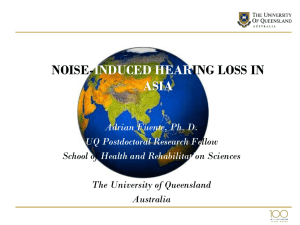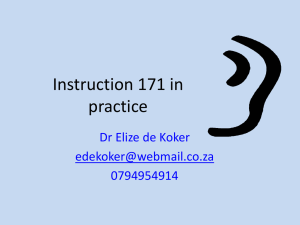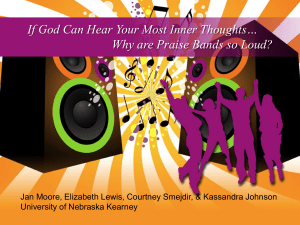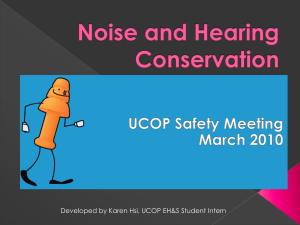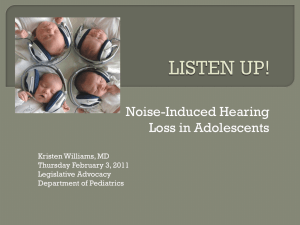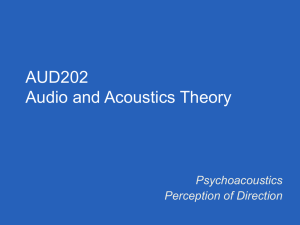noise-induced hearing loss in small-scale industries
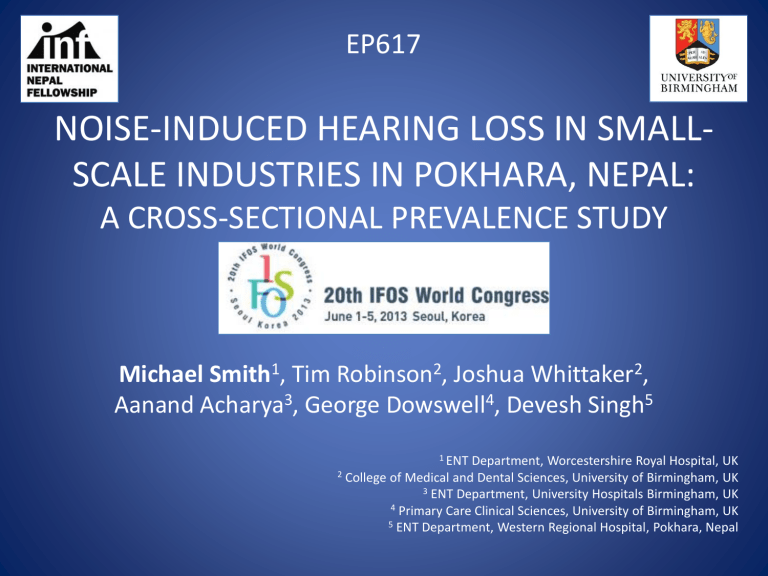
EP617
NOISE-INDUCED HEARING LOSS IN SMALL-
SCALE INDUSTRIES IN POKHARA, NEPAL:
A CROSS-SECTIONAL PREVALENCE STUDY
Michael Smith 1 , Tim Robinson 2 , Joshua Whittaker 2 ,
Aanand Acharya 3 , George Dowswell 4 , Devesh Singh 5
1 ENT Department, Worcestershire Royal Hospital, UK
2 College of Medical and Dental Sciences, University of Birmingham, UK
3 ENT Department, University Hospitals Birmingham, UK
5
4 Primary Care Clinical Sciences, University of Birmingham, UK
ENT Department, Western Regional Hospital, Pokhara, Nepal
INTRODUCTION
• Noise-induced hearing loss (NIHL) is an irreversible sensorineural hearing impairment characterised by high frequency (3−6 kHz) hearing loss.
• Consequences include social isolation, impaired communication, increased injury risk and reduced productivity for employers.
• Risk of NIHL increases with magnitude and duration of noise exposure.
• Regular exposure to >85 dBA considered hazardous to hearing.
• WHO estimate 16% of adult-onset hearing loss in South-East Asia attributable to occupational noise.
NIHL in Nepal
• Joshi et al. studied environmental NIHL in Kathmandu.
Retrospective cohort: cases exposed >70dbA (n=36), controls <55 dBA (n=25). OR=4.2 (4.0 when adjusted for occupational noise).
• No previous occupational NIHL research identified.
• Economically active population = 16.6 million.
• >95% work informally; not covered by occupational health and safety legislation.
• Substantial proportion at risk of NIHL.
• Need for research to support generation of noise permissible exposure limit (PEL) legislation.
Aim
To assess occupational noise exposure, hearing thresholds and NIHL prevalence in two small-scale industries in
Pokhara, Nepal, and compare to non-exposed controls
METHODS AND MATERIALS
• Cross-sectional prevalence study based in Pokhara, Kaski District.
– Conducted between February and April 2012.
• Convenience sampling of workplaces:
− Metal and wood workers (exposed groups).
− Hotel workers (control group).
Exclusion Criteria
• Aged <15 years.
• Working in current occupation <6 months.
• Current bilateral outer/middle ear pathology.
• Permanent bilateral hearing loss preceding occupational noise exposure.
Assessment Protocol
• Noise exposure: Average workplace noise (L
Aeq
) measured over 1 hour and extrapolated to an 8-hour working day (L
Aeq,8h
) for each participant.
• All consented individuals received:
– Hearing and occupational history questionnaire.
– Otoscopy (exclusion/inclusion confirmed by ENT referral where necessary).
– Air-conduction audiometry at 0.5, 1, 2 and 4 kHz.
• Those with a single ear average threshold >25dBHL OR >25dBHL at 4kHz, proceeded to:
– Air-conduction audiometry at 3, 6 and 8 kHz.
– Bone-conduction audiometry at 1, 2 and 4 kHz.
– Masked thresholds where necessary according to British Society of Audiology standards.
• Peak threshold between 3-6kHz (‘notch configuration’) = NIHL.
Stage 1: Questionnaire Stage 2: Otoscopy Stage 3: Audiometry
Met Exclusion
Criteria n=122
Consent n=487
Included n=359
Lost to Follow Up n=28
Proceeded to
Audiometry n=331
Excluded after
Audiometry n=4
Metal n=99
Final Dataset n=327
Wood n=124
Withdrew
Consent n=6
Hotel n=104
RESULTS - Demographics
Demographic
Data n
Age – median years (IQR)
Gender – % males
Smoking – %
(median packyears, IQR)
Time in occupation – median years
(IQR)
Hotel
Workers
104
26.5
(21−35)
76.92
34.62
(0, 0−0.40)
4
(2−12)
Metal
Workers
99
24
(21−38)
98.99
48.48
(0, 0−0.95)
4
(1.5−12)
Wood
Workers
124
25
(20−36)
100.00
39.52
(0, 0−0.18)
6
(2−15)
Difference
(Kruskal-Wallis or chi-squared)
-
Non-significant
P= 0.854
Significant
P<0.001
Significant
P= 0.003
Non-Significant
P=0.191
• 67.15% of recruited completed assessment
• Sample from 17 hotels, 13 metal works and 15 wood works
• All continuous data non-normal (K-S test)
• 82.26% had a smoking history of <1 pack-year with 4.28% ≥ 5 pack-years
• 50.15% aged ≤ 25 years; 89.60% ≤45 years
RESULTS – NIHL Prevalence
Population n
Hotel Workers 104
Metal Workers 99
Hotel Workers 104
Wood Workers 124
NIHL prevalence
(%)
5.05
35.35
5.05
27.37
Difference
(Chi-squared)
Significant
P<0.001
Significant
P<0.001
Odds Ratio
(95% CI)
17.83
(5.53−57.51)
11.46
(3.68−35.70)
RESULTS - continued
• Significant difference in average hearing threshold distribution
between controls and exposed (medians = 11.25 dBHL vs. 17.50
dBHL; P<0.001). Non-significant difference in distribution between exposed groups (medians = metal 16.88 dBHL vs. wood 18.10
dBHL; P=0.403).
• L
Aeq,8h distribution significantly different between controls and
exposed (medians = hotel 59.10 dBA, metal 80.56 dBA, wood
85.10 dBA; P<0.001). Noise levels ranged between 51.4−68.6 dBA at hotel sites, 65.3−84.7 dBA at metal sites and 71.2−93.9 dBA at wood sites.
• All odds ratios generated through binary logistic regression,
adjusted for age and time in occupation. All other demographics were non-significant in predicting risk of NIHL.
• Odds Ratio for risk of NIHL for any exposed vs. control = 13.44
(95% CI= 4.69−38.54).
60
50
40
30
20
Hotel Workers
Metal Workers
Wood Workers
R² = 0,2505
R² = 0,1474
R² = 0,2559
10
0
10 20 30 40
Age (Years)
50 60 70
Plot of average hearing threshold against age, showing increased hearing thresholds in noise-exposed groups
DISCUSSION
• As expected, occupational noise exposure, hearing thresholds and
NIHL prevalence significantly higher in metal and wood industries.
– Young age distribution and short exposure time may mask true disability associated with NIHL.
– Significant differences in smoking level, but low pack-years so unlikely to significantly impact on hearing .
• Lack of comparable results as previous studies in small-scale workshop industries recruited significantly smaller samples.
• Industrialisation and a growing economically active population in Nepal likely to put further people at risk.
• Occupational health and safety guidelines currently provide minimal protection for workers.
Limitations
• Convenience sampling reduces generalisability of results.
• Workplace noise assessment did not account for variation in noise exposure levels caused by powercuts, compromising validity of
L
Aeq,8h as comparator.
• Inability of data collection tool to standardise noise exposure and hearing history.
CONCLUSIONS
• Workers in small-scale metal and wood industries appear to be at significantly higher risk of NIHL, compared to control subjects.
• There is a need for hearing conservation policies to cover a growing workforce in Nepal.
• These measures may alleviate the effects of a widespread, yet preventable hearing impairment.
References
1. Concha-Barrientos et al. Occupational noise: assessing the burden of disease from work-related hearing impairment at national and local levels.
WHO Environmental Burden of Disease, No 9. Geneva, WHO (2004)
2. Nelson et al. The global burden of occupational noise-induced hearing loss.
American Journal of Industrial Medicine (2005) 48(6):446-458
3. Joshi et al. Environmental noise induced hearing loss in Nepal. Kathmandu
University Medical Journal (2003) 1(3):177-183
4. International Labour Organisation. Labour and Social Trends in Nepal 2010.
Geneva, ILO (2010)
•
This study was carried out as part of the
International Health course at the University of
Birmingham, UK.
•
Logistical support was provided by the International
Nepal Fellowship.
•
